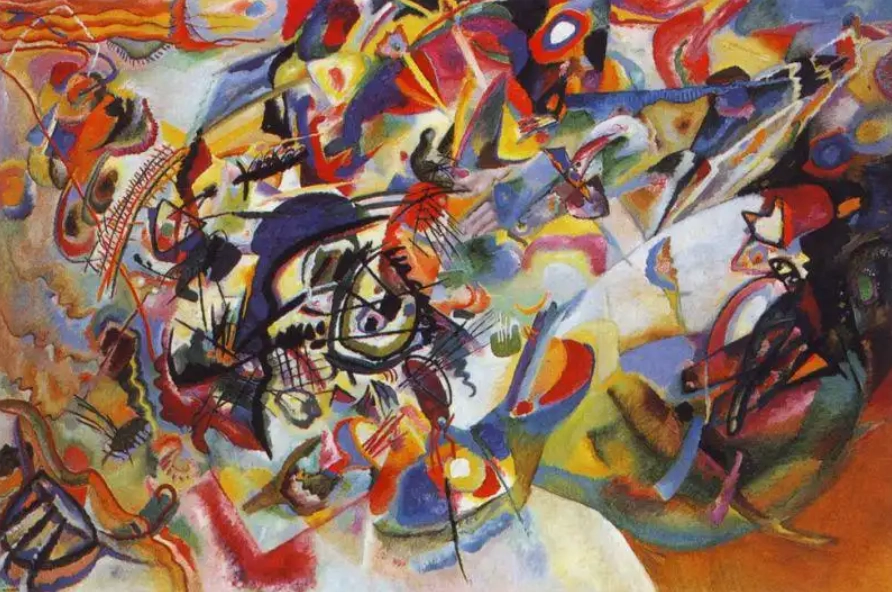Exploring the Balance of Composition VII by Kandinsky


Experience the transformative genius of Wassily Kandinsky through his iconic masterpiece, "Composition VII." As a trailblazer in abstract art, Kandinsky shattered traditional artistic conventions, inviting viewers into a realm where emotions and ideas transcend physical forms. In "Composition VII," Kandinsky's bold use of color and geometric shapes creates a dynamic interplay, evoking a sense of rhythmic movement and boundless energy. Amidst the seemingly chaotic arrangement, there exists a hidden order—a harmony that beckons viewers to immerse themselves in the artist's visionary exploration of the balance between chaos and order.
Kandinsky's revolutionary approach to art challenged viewers to venture beyond the confines of realism and embrace the power of abstract expression. By harnessing the language of colors and shapes, he sought to convey profound emotions and universal truths. "Composition VII" serves as a testament to Kandinsky's belief in the transformative potential of art, inviting viewers to embark on a journey of introspection and discovery.
With each brushstroke, Kandinsky invites us to question our perceptions and embrace the boundless possibilities of the imagination. Through "Composition VII," he invites us to contemplate the intricate interplay between chaos and order, urging us to find meaning amidst the vibrant tapestry of shapes and colors. As we delve into Kandinsky's mesmerizing masterpiece, we are reminded of the enduring power of art to transcend boundaries and ignite the flames of creativity within us.
Embark on a journey into abstraction's realm
Step into the revolutionary world of Wassily Kandinsky's Composition VII, a hallmark of abstract artistry. As a trailblazer in abstraction, Kandinsky redefines traditional representation, offering a canvas where emotions and concepts reign supreme over tangible forms. Crafted in 1913, Composition VII mesmerizes with its interplay of vibrant hues, dynamic shapes, and rhythmic lines, inviting viewers to decipher its intricate narrative. Experience the fusion of chaos and order, where Kandinsky's bold strokes create a symphony of visual expression, challenging perceptions and inspiring contemplation.
At first sight, Composition VII may seem like an explosion of colors, shapes, and lines, challenging traditional representation. However, beneath the surface chaos lies a hidden harmony waiting to be discovered. Divided into distinct sections, each with its unique color scheme and arrangement, the painting captivates with its intricate interplay of forms. Kandinsky's masterful use of geometric shapes, alongside bold color choices, imbues the artwork with a sense of structure and emotional depth, inviting viewers to explore the depths of abstract expressionism.
Color Symphony
In Composition VII, Kandinsky's skillful use of color is truly remarkable. He believed that colors could stir emotions, and here he blends warm and cool hues to create a captivating contrast. Reds and yellows dominate the upper portion, while blues and greens command the lower half, producing a visual tension that adds dynamism. Each color is purposefully selected to evoke specific emotions – warmth and intensity in the reds and yellows, and calmness in the blues and greens. This deliberate interplay creates a harmonious balance, guiding the viewer through an emotional journey within the artwork.
Kandinsky's adept use of geometric shapes and lines is a cornerstone of the artwork's harmony. These shapes interact dynamically, creating a sense of movement and rhythm. Circular forms ripple outward, while angular lines provide direction and flow. Kandinsky employs repetition and variation in these shapes and lines, adding layers of complexity. Each element is thoughtfully positioned to achieve balance and symmetry, contributing to the painting's overall harmony. While initially appearing chaotic, closer examination reveals deliberate placement and purpose behind each element, culminating in a harmonious composition.
The Heartbeat of Melody
Kandinsky's Composition VII resonates with musicality, mirroring his belief in art's ability to express abstract emotions akin to music. The painting's rhythmic composition dances to an invisible melody, embodying movement and vitality. Each element plays a unique role, harmonizing to create a visual symphony that showcases Kandinsky's artistic brilliance.
Conclusion
Composition VII by Kandinsky stands as a masterpiece, beckoning us into the realm of abstract art to uncover harmony amidst chaos. Through his adept use of color, shapes, and lines, Kandinsky crafts a visual symphony that resonates with our emotions and senses. This artwork embodies his belief in art's ability to transcend representation and speak directly to the soul. As we contemplate Composition VII, we're reminded of abstraction's power to convey profound meaning and emotion. Kandinsky's enduring masterpiece continues to inspire, urging us to explore the boundless avenues of artistic expression. Within the intricate interplay of shapes, colors, and lines in Composition VII, Kandinsky unveils a hidden harmony that speaks to our innermost selves. This abstract gem invites us to delve into a realm of emotions and ideas through the visual language of art, transcending traditional forms to orchestrate a symphony for the senses.
Subscribe to our newsletter to get updated and enjoy a 10% voucher
Apr 12 2024 / Biography Art History



